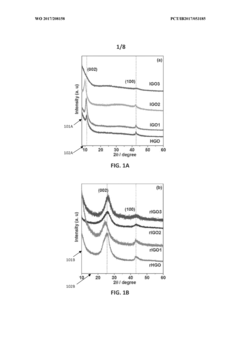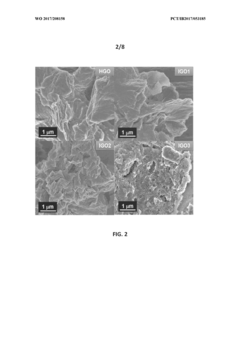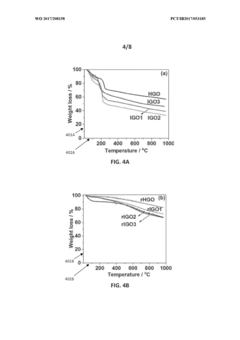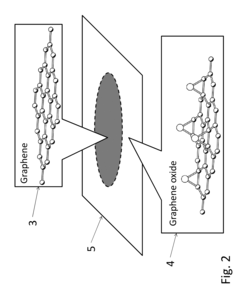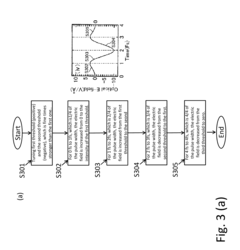Transient chemical and structural changes in graphene oxide during ripening
MAY 13, 20259 MIN READ
Generate Your Research Report Instantly with AI Agent
Patsnap Eureka helps you evaluate technical feasibility & market potential.
Graphene Oxide Evolution and Research Objectives
Graphene oxide (GO) has emerged as a promising material in various fields due to its unique properties and versatile applications. The evolution of GO research has been marked by significant advancements in synthesis methods, characterization techniques, and understanding of its structure-property relationships. The primary objective of studying transient chemical and structural changes in GO during ripening is to gain deeper insights into the material's behavior and optimize its properties for specific applications.
The research in this area aims to elucidate the dynamic processes that occur during GO ripening, which can significantly impact its final characteristics. Understanding these changes is crucial for controlling the material's properties and tailoring them for specific uses. The ripening process involves complex interactions between functional groups, structural rearrangements, and environmental factors, all of which contribute to the evolution of GO's physical and chemical properties over time.
One of the key goals is to develop a comprehensive model of GO ripening that can predict and explain the observed changes. This includes investigating the kinetics of deoxygenation, the formation and transformation of various oxygen-containing functional groups, and the restoration of sp2 carbon networks. Researchers are particularly interested in understanding how these processes affect the material's electronic, mechanical, and chemical properties.
Another important objective is to explore the influence of external factors on GO ripening, such as temperature, pH, and the presence of reducing agents or other chemical species. By manipulating these parameters, scientists aim to develop controlled ripening protocols that can yield GO with specific desired properties. This could lead to the production of tailored GO materials for applications in electronics, energy storage, catalysis, and biomedical fields.
Furthermore, the research seeks to develop advanced in situ characterization techniques that can capture the transient changes in GO during ripening with high temporal and spatial resolution. This includes the use of spectroscopic methods, microscopy techniques, and computational modeling to provide a multi-scale understanding of the ripening process.
Ultimately, the research objectives extend beyond fundamental understanding to practical applications. Scientists aim to leverage the knowledge gained from studying GO ripening to design novel GO-based materials with enhanced performance and stability. This could lead to breakthroughs in areas such as water purification, energy conversion, and nanocomposite materials.
By addressing these research objectives, the scientific community hopes to unlock the full potential of GO and pave the way for its widespread adoption in various technological applications. The insights gained from studying the transient changes during ripening will not only advance our understanding of GO but also contribute to the broader field of two-dimensional materials science.
The research in this area aims to elucidate the dynamic processes that occur during GO ripening, which can significantly impact its final characteristics. Understanding these changes is crucial for controlling the material's properties and tailoring them for specific uses. The ripening process involves complex interactions between functional groups, structural rearrangements, and environmental factors, all of which contribute to the evolution of GO's physical and chemical properties over time.
One of the key goals is to develop a comprehensive model of GO ripening that can predict and explain the observed changes. This includes investigating the kinetics of deoxygenation, the formation and transformation of various oxygen-containing functional groups, and the restoration of sp2 carbon networks. Researchers are particularly interested in understanding how these processes affect the material's electronic, mechanical, and chemical properties.
Another important objective is to explore the influence of external factors on GO ripening, such as temperature, pH, and the presence of reducing agents or other chemical species. By manipulating these parameters, scientists aim to develop controlled ripening protocols that can yield GO with specific desired properties. This could lead to the production of tailored GO materials for applications in electronics, energy storage, catalysis, and biomedical fields.
Furthermore, the research seeks to develop advanced in situ characterization techniques that can capture the transient changes in GO during ripening with high temporal and spatial resolution. This includes the use of spectroscopic methods, microscopy techniques, and computational modeling to provide a multi-scale understanding of the ripening process.
Ultimately, the research objectives extend beyond fundamental understanding to practical applications. Scientists aim to leverage the knowledge gained from studying GO ripening to design novel GO-based materials with enhanced performance and stability. This could lead to breakthroughs in areas such as water purification, energy conversion, and nanocomposite materials.
By addressing these research objectives, the scientific community hopes to unlock the full potential of GO and pave the way for its widespread adoption in various technological applications. The insights gained from studying the transient changes during ripening will not only advance our understanding of GO but also contribute to the broader field of two-dimensional materials science.
Market Applications of Graphene Oxide
Graphene oxide (GO) has emerged as a versatile material with a wide range of potential applications across various industries. The market for GO is rapidly expanding due to its unique properties, including high surface area, excellent mechanical strength, and tunable electronic properties. In the electronics sector, GO is being explored for use in flexible displays, touchscreens, and energy storage devices. Its high conductivity and transparency make it an attractive alternative to traditional materials like indium tin oxide (ITO) in transparent electrodes.
In the energy industry, GO shows promise for improving the efficiency of solar cells and fuel cells. Its large surface area and ability to be functionalized make it an excellent candidate for catalyst supports and electrode materials. Additionally, GO-based membranes are being developed for water purification and desalination applications, addressing global water scarcity issues.
The biomedical field is another area where GO is gaining traction. Its biocompatibility and ability to be functionalized with various molecules make it suitable for drug delivery systems, biosensors, and tissue engineering scaffolds. GO-based materials are being investigated for their potential in cancer therapy, wound healing, and antimicrobial applications.
In the aerospace and automotive industries, GO is being explored as a lightweight and strong material for composite reinforcement. Its incorporation into polymers and other materials can lead to significant improvements in mechanical properties while reducing overall weight, contributing to fuel efficiency and performance enhancements.
The environmental remediation sector is also benefiting from GO's properties. Its high adsorption capacity makes it an effective material for removing pollutants from water and air. GO-based materials are being developed for the removal of heavy metals, organic contaminants, and even radioactive materials from contaminated environments.
As research into GO continues to advance, new applications are constantly emerging. The material's potential in quantum computing, thermal management, and smart textiles is being explored, opening up new market opportunities. However, challenges remain in scaling up production, reducing costs, and addressing potential environmental and health concerns associated with nanomaterials.
The market for GO is expected to grow significantly in the coming years, driven by increasing demand across multiple industries and ongoing research and development efforts. As the understanding of GO's transient chemical and structural changes during ripening improves, it is likely to lead to more refined and targeted applications, further expanding its market potential.
In the energy industry, GO shows promise for improving the efficiency of solar cells and fuel cells. Its large surface area and ability to be functionalized make it an excellent candidate for catalyst supports and electrode materials. Additionally, GO-based membranes are being developed for water purification and desalination applications, addressing global water scarcity issues.
The biomedical field is another area where GO is gaining traction. Its biocompatibility and ability to be functionalized with various molecules make it suitable for drug delivery systems, biosensors, and tissue engineering scaffolds. GO-based materials are being investigated for their potential in cancer therapy, wound healing, and antimicrobial applications.
In the aerospace and automotive industries, GO is being explored as a lightweight and strong material for composite reinforcement. Its incorporation into polymers and other materials can lead to significant improvements in mechanical properties while reducing overall weight, contributing to fuel efficiency and performance enhancements.
The environmental remediation sector is also benefiting from GO's properties. Its high adsorption capacity makes it an effective material for removing pollutants from water and air. GO-based materials are being developed for the removal of heavy metals, organic contaminants, and even radioactive materials from contaminated environments.
As research into GO continues to advance, new applications are constantly emerging. The material's potential in quantum computing, thermal management, and smart textiles is being explored, opening up new market opportunities. However, challenges remain in scaling up production, reducing costs, and addressing potential environmental and health concerns associated with nanomaterials.
The market for GO is expected to grow significantly in the coming years, driven by increasing demand across multiple industries and ongoing research and development efforts. As the understanding of GO's transient chemical and structural changes during ripening improves, it is likely to lead to more refined and targeted applications, further expanding its market potential.
Current Challenges in Graphene Oxide Synthesis
Graphene oxide (GO) synthesis presents several significant challenges that researchers and manufacturers are currently grappling with. One of the primary issues is the lack of precise control over the oxidation process, which leads to inconsistencies in the final product's structure and properties. The conventional Hummers method, while widely used, often results in a heterogeneous mixture of GO sheets with varying degrees of oxidation. This variability can significantly impact the material's performance in various applications, from electronics to biomedical devices.
Another major challenge is the scalability of GO production. While laboratory-scale synthesis can produce high-quality GO, scaling up to industrial levels often leads to compromises in quality and consistency. The large-scale production of GO also faces environmental concerns due to the use of strong oxidizing agents and acids, which can generate hazardous waste and pose safety risks.
The presence of residual impurities in GO is another persistent issue. Despite extensive washing procedures, trace amounts of oxidizing agents, metal ions, and other contaminants can remain in the final product. These impurities can interfere with GO's properties and limit its use in sensitive applications such as biomedical implants or high-performance electronics.
Controlling the size and thickness of GO sheets during synthesis is also challenging. The exfoliation process can lead to a wide distribution of sheet sizes and thicknesses, which can be problematic for applications requiring uniform material properties. Additionally, the tendency of GO sheets to restack or aggregate during processing and drying poses difficulties in maintaining the material's unique 2D structure and associated properties.
The reduction of GO to reduced graphene oxide (rGO) or graphene-like materials is another area of concern. Current reduction methods often fail to fully restore the sp2 carbon network, resulting in materials with inferior electrical and mechanical properties compared to pristine graphene. Developing more efficient and less damaging reduction techniques remains an active area of research.
Lastly, the characterization and quality control of GO present significant challenges. The complex and variable nature of GO makes it difficult to establish standardized methods for assessing its quality and properties. This lack of standardization hampers the comparison of results across different studies and impedes the development of reliable commercial products based on GO.
Another major challenge is the scalability of GO production. While laboratory-scale synthesis can produce high-quality GO, scaling up to industrial levels often leads to compromises in quality and consistency. The large-scale production of GO also faces environmental concerns due to the use of strong oxidizing agents and acids, which can generate hazardous waste and pose safety risks.
The presence of residual impurities in GO is another persistent issue. Despite extensive washing procedures, trace amounts of oxidizing agents, metal ions, and other contaminants can remain in the final product. These impurities can interfere with GO's properties and limit its use in sensitive applications such as biomedical implants or high-performance electronics.
Controlling the size and thickness of GO sheets during synthesis is also challenging. The exfoliation process can lead to a wide distribution of sheet sizes and thicknesses, which can be problematic for applications requiring uniform material properties. Additionally, the tendency of GO sheets to restack or aggregate during processing and drying poses difficulties in maintaining the material's unique 2D structure and associated properties.
The reduction of GO to reduced graphene oxide (rGO) or graphene-like materials is another area of concern. Current reduction methods often fail to fully restore the sp2 carbon network, resulting in materials with inferior electrical and mechanical properties compared to pristine graphene. Developing more efficient and less damaging reduction techniques remains an active area of research.
Lastly, the characterization and quality control of GO present significant challenges. The complex and variable nature of GO makes it difficult to establish standardized methods for assessing its quality and properties. This lack of standardization hampers the comparison of results across different studies and impedes the development of reliable commercial products based on GO.
Existing Methods for Studying GO Ripening
01 Reduction and deoxygenation of graphene oxide
Various methods are employed to reduce and deoxygenate graphene oxide, leading to structural changes and the formation of reduced graphene oxide (rGO). These processes involve removing oxygen-containing functional groups and restoring the sp2 carbon network, resulting in improved electrical and mechanical properties.- Reduction and deoxygenation of graphene oxide: Various methods are employed to reduce and deoxygenate graphene oxide, altering its chemical structure and properties. These processes can involve thermal, chemical, or electrochemical treatments, resulting in reduced graphene oxide (rGO) with enhanced electrical conductivity and mechanical strength.
- Functionalization of graphene oxide: Graphene oxide can be functionalized with various chemical groups or molecules to modify its properties and enhance its compatibility with different materials. This process can lead to changes in the surface chemistry, reactivity, and dispersibility of graphene oxide.
- Structural modifications through exfoliation and intercalation: Exfoliation and intercalation processes can be used to modify the structure of graphene oxide, affecting its layer spacing and surface area. These modifications can result in changes to the material's physical and chemical properties, such as improved dispersion in solvents or enhanced adsorption capabilities.
- Chemical doping of graphene oxide: Chemical doping involves the introduction of heteroatoms or functional groups into the graphene oxide structure, altering its electronic properties and chemical reactivity. This process can be used to tailor the material for specific applications, such as energy storage or catalysis.
- Thermal annealing and phase transformations: Thermal annealing processes can induce structural and chemical changes in graphene oxide, including the removal of oxygen-containing groups and the formation of defects. These transformations can lead to changes in the material's crystallinity, electrical conductivity, and mechanical properties.
02 Functionalization and chemical modification of graphene oxide
Graphene oxide undergoes chemical modifications through the addition of functional groups or molecules to its surface. These modifications alter the chemical and structural properties of graphene oxide, enabling tailored characteristics for specific applications such as improved dispersibility, reactivity, or compatibility with other materials.Expand Specific Solutions03 Thermal treatment and annealing of graphene oxide
Thermal processes are used to induce chemical and structural changes in graphene oxide. These treatments can lead to the removal of oxygen-containing groups, restoration of the graphene structure, and modification of the interlayer spacing. The resulting material often exhibits enhanced electrical conductivity and mechanical strength.Expand Specific Solutions04 Exfoliation and size control of graphene oxide sheets
Various techniques are employed to exfoliate graphene oxide and control the size of the resulting sheets. These processes can involve mechanical, chemical, or thermal methods, leading to changes in the layer thickness, lateral dimensions, and surface area of graphene oxide. The resulting materials often exhibit unique properties based on their size and morphology.Expand Specific Solutions05 Doping and heteroatom incorporation in graphene oxide
Graphene oxide undergoes doping processes or incorporation of heteroatoms to modify its electronic structure and chemical properties. These modifications can introduce new functionalities, alter the bandgap, or enhance specific characteristics such as catalytic activity or sensing capabilities.Expand Specific Solutions
Key Players in Graphene Oxide Research
The field of transient chemical and structural changes in graphene oxide during ripening is in its early developmental stage, with significant research potential. The market size is expanding as graphene-based technologies gain traction across various industries. While the technology is still evolving, several key players are advancing its maturity. Institutions like the National University of Singapore, Massachusetts Institute of Technology, and Tsinghua University are at the forefront of academic research. Companies such as Samsung Electronics Co., Ltd. and Hitachi Ltd. are driving commercial applications. The involvement of diverse organizations, from universities to industrial giants, indicates a competitive landscape with opportunities for breakthrough innovations and market leadership.
National University of Singapore
Technical Solution: The National University of Singapore has developed a novel approach to study the transient chemical and structural changes in graphene oxide during ripening. Their method involves in-situ characterization techniques, including X-ray photoelectron spectroscopy (XPS) and Raman spectroscopy, to monitor the evolution of functional groups and structural defects in real-time. This allows for a comprehensive understanding of the ripening process, including the kinetics of oxygen reduction and the formation of sp2 carbon domains.
Strengths: High-resolution real-time monitoring, comprehensive analysis of chemical and structural changes. Weaknesses: Potentially complex and expensive experimental setup, limited to laboratory conditions.
Massachusetts Institute of Technology
Technical Solution: MIT has pioneered a multi-scale modeling approach to investigate the transient changes in graphene oxide during ripening. Their method combines molecular dynamics simulations with density functional theory calculations to predict the evolution of chemical functionalities and structural reorganization at different time scales. This computational approach allows for the exploration of various ripening conditions and their effects on the final graphene oxide properties.
Strengths: Ability to predict and optimize ripening conditions, cost-effective compared to experimental methods. Weaknesses: Requires validation with experimental data, may not capture all real-world complexities.
Core Innovations in GO Characterization
Graphene oxide particles and method of making and using them
PatentWO2017208158A1
Innovation
- A method involving the oxidation of graphite in a mixture of phosphoric and sulfuric acids with KMnO4, followed by dispersion in water and adjustment of pH, results in high-purity graphene oxide with improved capacitance, which can be further reduced to produce reduced graphene oxide particles with enhanced specific capacitance and stability.
Structure of graphene oxide, the method of fabrication of the structure, the method of fabricating field-effect transistor using the structure
PatentInactiveUS20140017440A1
Innovation
- The use of a femtosecond laser with specific pulse shape and intensity to selectively reduce graphene oxide, allowing for spatially segregated regions of graphene oxide and pristine graphene on a single sheet, enabling controlled patterning and reduction of oxygen atoms to create desired conducting and insulating areas.
Environmental Impact of GO Production
The production of graphene oxide (GO) has gained significant attention due to its potential applications in various fields. However, the environmental impact of GO production is a crucial aspect that requires careful consideration. The synthesis of GO typically involves the oxidation of graphite using strong oxidizing agents, such as potassium permanganate and sulfuric acid, which can lead to the generation of hazardous waste and potentially harmful byproducts. The use of these chemicals raises concerns about their disposal and potential contamination of water sources and soil.
One of the primary environmental concerns associated with GO production is the release of toxic gases, such as carbon monoxide and sulfur dioxide, during the oxidation process. These emissions can contribute to air pollution and pose health risks to workers and nearby communities if not properly managed. Additionally, the large-scale production of GO may result in increased energy consumption and greenhouse gas emissions, further contributing to climate change.
Water usage and contamination are also significant environmental issues in GO production. The process often requires substantial amounts of water for washing and purification steps, potentially straining local water resources. Moreover, the wastewater generated during production may contain residual chemicals and GO particles, which can be challenging to remove using conventional water treatment methods.
The disposal of GO-containing waste presents another environmental challenge. Improper handling and disposal of GO-contaminated materials can lead to the release of nanoparticles into the environment, potentially affecting ecosystems and human health. The long-term environmental fate and potential bioaccumulation of GO in various organisms are still not fully understood, necessitating further research to assess the ecological risks associated with its production and use.
To address these environmental concerns, researchers and manufacturers are exploring more sustainable production methods for GO. Green synthesis approaches, such as using environmentally friendly reducing agents and milder oxidation conditions, are being developed to minimize the use of harsh chemicals and reduce waste generation. Additionally, efforts are being made to improve the efficiency of GO production processes, optimize resource utilization, and implement closed-loop systems for water and chemical recycling.
As the demand for GO continues to grow, it is crucial to prioritize the development of environmentally responsible production methods and implement stringent waste management practices. This includes investing in advanced air and water treatment technologies, promoting the use of renewable energy sources in production facilities, and establishing comprehensive recycling and disposal protocols for GO-containing materials. By addressing these environmental challenges, the GO industry can work towards more sustainable production practices that minimize its ecological footprint while harnessing the material's potential for innovative applications.
One of the primary environmental concerns associated with GO production is the release of toxic gases, such as carbon monoxide and sulfur dioxide, during the oxidation process. These emissions can contribute to air pollution and pose health risks to workers and nearby communities if not properly managed. Additionally, the large-scale production of GO may result in increased energy consumption and greenhouse gas emissions, further contributing to climate change.
Water usage and contamination are also significant environmental issues in GO production. The process often requires substantial amounts of water for washing and purification steps, potentially straining local water resources. Moreover, the wastewater generated during production may contain residual chemicals and GO particles, which can be challenging to remove using conventional water treatment methods.
The disposal of GO-containing waste presents another environmental challenge. Improper handling and disposal of GO-contaminated materials can lead to the release of nanoparticles into the environment, potentially affecting ecosystems and human health. The long-term environmental fate and potential bioaccumulation of GO in various organisms are still not fully understood, necessitating further research to assess the ecological risks associated with its production and use.
To address these environmental concerns, researchers and manufacturers are exploring more sustainable production methods for GO. Green synthesis approaches, such as using environmentally friendly reducing agents and milder oxidation conditions, are being developed to minimize the use of harsh chemicals and reduce waste generation. Additionally, efforts are being made to improve the efficiency of GO production processes, optimize resource utilization, and implement closed-loop systems for water and chemical recycling.
As the demand for GO continues to grow, it is crucial to prioritize the development of environmentally responsible production methods and implement stringent waste management practices. This includes investing in advanced air and water treatment technologies, promoting the use of renewable energy sources in production facilities, and establishing comprehensive recycling and disposal protocols for GO-containing materials. By addressing these environmental challenges, the GO industry can work towards more sustainable production practices that minimize its ecological footprint while harnessing the material's potential for innovative applications.
Scalability of GO Manufacturing
The scalability of graphene oxide (GO) manufacturing is a critical factor in its potential for widespread industrial applications. Current production methods, such as the modified Hummers method, have shown promise in laboratory settings but face significant challenges when scaled up to industrial levels. The primary obstacles include maintaining consistent quality, reducing production costs, and minimizing environmental impact.
One of the key issues in scaling up GO production is the control of oxidation levels and the uniformity of the final product. As batch sizes increase, it becomes more difficult to ensure that all graphene sheets are oxidized to the same degree, leading to inconsistencies in the material properties. This variability can significantly impact the performance of GO in various applications, from electronics to composites.
Another challenge is the high cost associated with large-scale production. The modified Hummers method, while effective, requires expensive reagents and generates a considerable amount of waste. As production scales up, the cost of raw materials and waste management becomes a significant factor in the overall economic viability of GO manufacturing.
Environmental concerns also play a crucial role in the scalability of GO production. The use of strong oxidizing agents and acids in the manufacturing process poses potential risks to the environment and worker safety. Developing more environmentally friendly production methods is essential for the sustainable scale-up of GO manufacturing.
Despite these challenges, several promising approaches are being explored to improve the scalability of GO production. Continuous flow reactors, for instance, offer the potential for more consistent oxidation and better control over reaction conditions. This approach could lead to higher quality GO production at larger scales.
Researchers are also investigating alternative oxidation methods that use less harsh chemicals or even electrochemical processes. These methods could potentially reduce both the environmental impact and production costs associated with GO manufacturing.
Advances in purification and exfoliation techniques are also contributing to improved scalability. Techniques such as centrifugation and filtration are being optimized for large-scale production, allowing for more efficient separation of GO sheets and removal of impurities.
As the demand for GO continues to grow across various industries, addressing these scalability challenges becomes increasingly important. The development of more efficient, cost-effective, and environmentally friendly production methods will be crucial in realizing the full potential of GO in large-scale applications.
One of the key issues in scaling up GO production is the control of oxidation levels and the uniformity of the final product. As batch sizes increase, it becomes more difficult to ensure that all graphene sheets are oxidized to the same degree, leading to inconsistencies in the material properties. This variability can significantly impact the performance of GO in various applications, from electronics to composites.
Another challenge is the high cost associated with large-scale production. The modified Hummers method, while effective, requires expensive reagents and generates a considerable amount of waste. As production scales up, the cost of raw materials and waste management becomes a significant factor in the overall economic viability of GO manufacturing.
Environmental concerns also play a crucial role in the scalability of GO production. The use of strong oxidizing agents and acids in the manufacturing process poses potential risks to the environment and worker safety. Developing more environmentally friendly production methods is essential for the sustainable scale-up of GO manufacturing.
Despite these challenges, several promising approaches are being explored to improve the scalability of GO production. Continuous flow reactors, for instance, offer the potential for more consistent oxidation and better control over reaction conditions. This approach could lead to higher quality GO production at larger scales.
Researchers are also investigating alternative oxidation methods that use less harsh chemicals or even electrochemical processes. These methods could potentially reduce both the environmental impact and production costs associated with GO manufacturing.
Advances in purification and exfoliation techniques are also contributing to improved scalability. Techniques such as centrifugation and filtration are being optimized for large-scale production, allowing for more efficient separation of GO sheets and removal of impurities.
As the demand for GO continues to grow across various industries, addressing these scalability challenges becomes increasingly important. The development of more efficient, cost-effective, and environmentally friendly production methods will be crucial in realizing the full potential of GO in large-scale applications.
Unlock deeper insights with Patsnap Eureka Quick Research — get a full tech report to explore trends and direct your research. Try now!
Generate Your Research Report Instantly with AI Agent
Supercharge your innovation with Patsnap Eureka AI Agent Platform!
